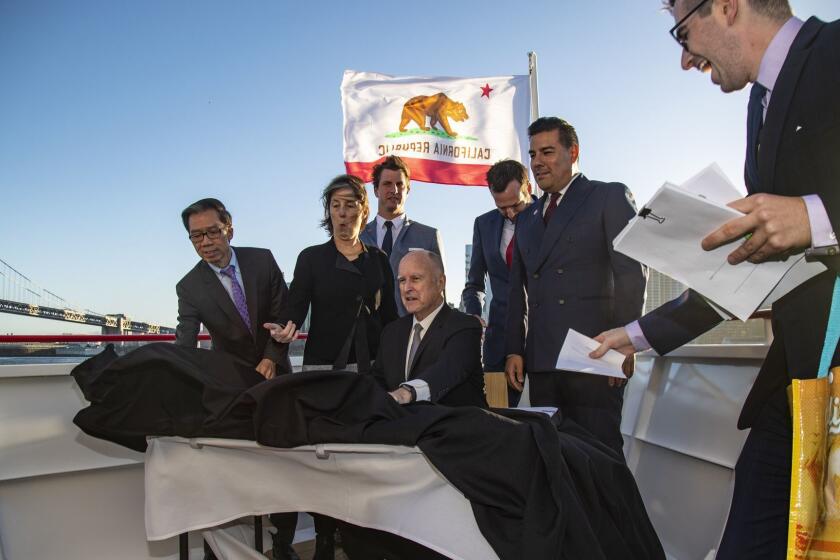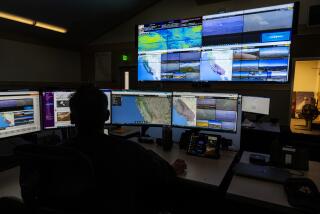California enlists surveillance satellites to sniff out greenhouse gas ‘super-emitters’
Years after former Gov. Jerry Brown pledged California would launch its “own damn satellite” to track planet-warming pollutants, the state plans to put not one, but two satellites in orbit to help it hunt for hard-to-find “super-emitters” of methane and carbon dioxide.
In an announcement Thursday, a partnership of government and research organizations working under a newly formed nonprofit called Carbon Mapper said it is on track to launch the satellites in 2023 using $100 million in funding from philanthropic groups.
The two satellites will be used to locate, quantify and make visible plumes of methane and carbon pollution, which remain major obstacles in the fight against climate change. Regulators and scientists say faster, more accurate monitoring is urgently needed to accelerate greenhouse gas reductions and keep global warming from reaching catastrophic levels.
The satellites’ targets will include oil and gas operations, waste management facilities, dairies and other industries that researchers say spew much of the state’s methane, a short-lived but powerful pollutant that is more than 80 times more effective at trapping heat than carbon dioxide.
“These sort of methane emissions are kind of like invisible wildfires across the landscape,” said Riley Duren, chief executive of Carbon Mapper and a research scientist at the University of Arizona. “No one can see them or smell them, and yet they’re incredibly damaging, not just to the local environment, but more importantly, globally.”
Methane accounts for about 10% of California’s greenhouse gas emissions, but that share is growing as the state’s carbon dioxide pollution declines. Methane leaks can also emit other health-damaging pollutants such as benzene.
Years of aircraft-based measurements across California have detected hundreds of previously hidden but highly concentrated plumes of methane. The Los Angeles basin, Central Valley and Bay Area stand out as “target-rich” areas, Duren said.
Between 2016 and 2018, Duren and other scientists surveyed hundreds of thousands of California facilities, pieces of equipment and infrastructure, including oil and gas wells, landfills, natural gas pipelines, and dairies. They found that about 600 “super-emitters” — less than 0.2% of the state’s infrastructure — were spewing more than one-third of the methane pollution. The biggest emitters were landfills and composting facilities, dairies, and oil and gas operations.
California air quality regulators, who are part of the project, said they lack the kind of detailed and frequent monitoring that is necessary to pinpoint invisible plumes of pollution. They plan to use the data to target enforcement actions and implement other emissions-cutting measures, which they say are vital to meeting California’s emission reduction goals on time. Those goals include slashing greenhouse gas emissions 40% below 1990 levels by 2030 and reaching carbon neutrality, or net-zero emissions, by 2045.
The program is an outgrowth of Brown’s 2018 announcement that California would launch its “own damn satellite” to track greenhouse gas emissions in response to the Trump administration’s attacks on climate science. The program has developed under Gov. Gavin Newsom, not as a state-run satellite program, but as a public-private partnership funded by donors. Use of the technology will not be limited to California and may be used to sniff out pollution hot spots across the globe.
Brown said this week that the program is exactly what he had in mind in 2018 and that he was looking forward to “learning about where is the methane coming from and where exactly — who is it, whose land, whose business,” and developing a plan to eliminate it.
“California’s satellites are long overdue and they will make a difference in identifying methane emissions all over California,” Brown said. “Very soon thereafter there will be more satellites and the real problem of methane will become obvious and quantifiable and identifiable, and that, I think, will lead to serious reduction in what is a very damaging super-pollutant.”
Brown, who earned the nickname “Gov. Moonbeam” in the 1970s for what was then viewed as a far-fetched proposal that California launch its own satellite, said the climate satellite initiative “is different from what I called for in 1978.”
“In more than 40 years there’s been a lot of innovation and development,” Brown added. “But I had the idea that space was a powerful resource and place from which to affect and improve things on Earth and things in California. That, at the time, was thought beyond the ken of the political mind.”
In a prepared statement, Newsom declared that “these home-grown satellites are a game-changer. They provide California with a powerful, state-of-the-art tool to help us slash emissions of the super-pollutant methane — within our own borders and around the world. That’s exactly the kind of dynamic, forward-thinking solution we need now to address the existential crisis of climate change.”
In addition to the state, other partners include NASA’s Jet Propulsion Laboratory, which will provide the hyperspectral imaging spectrometer for the first satellite; Planet, the San Francisco-based earth-imaging company that is designing and building the satellite; the University of Arizona; Arizona State University; and RMI. High Tide Foundation and Bloomberg Philanthropies are among the groups funding the work.
After two years of initial study and engineering, the group is moving ahead with phase one of the project, which includes launching the first two satellites. Phase two, slated for 2025, would involve a constellation of 20 or more satellites that could, collectively, measure high-priority targets on a daily basis, according to Jeffrey Guido, Planet’s director of special projects.
Regulators say the ground-based tools they rely on during field inspections, including infrared cameras and other instruments that sniff the air for methane gas, aren’t high-resolution enough, or deployed frequently enough, to keep tabs on the state’s vast array of methane-emitters. California’s oil and gas regulations, for instance, call for quarterly inspections, but that’s far too infrequent to detect and fix leaks, according to air quality officials.
“Getting timely information in front of sources responsible and being able to track whether strong mitigation efforts have been taken, that’s where we see an opportunity here,” said Richard Corey, executive officer of the California Air Resources Board. “Many sources, if armed with that data, are prompted to take action. If not, it’s a great tool to inspect and get someone in the field out to the source.”
The Air Resources Board is also developing an online portal to make the data collected by the satellites available to the public.
“We’re not saying we’re going to find every kilogram of methane or CO2 on the planet with this,” Duren said. “But these ‘super-emitters’ are common and they’re hard to find if you don’t have the right technology. So, if we can contribute to finding a significant fraction of them and mitigating them, then we will have done the world a service.”
More to Read
Sign up for Essential California
The most important California stories and recommendations in your inbox every morning.
You may occasionally receive promotional content from the Los Angeles Times.












